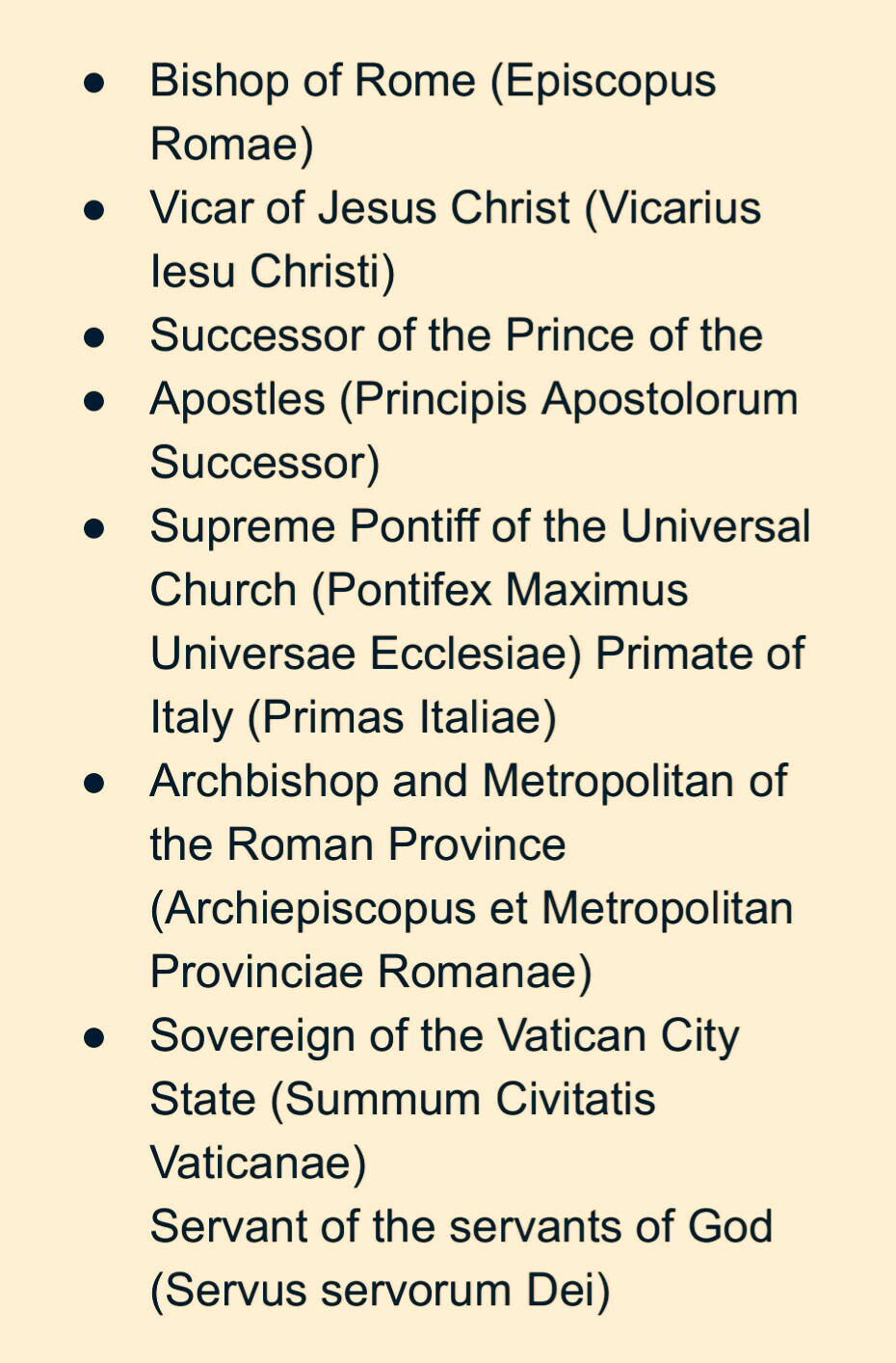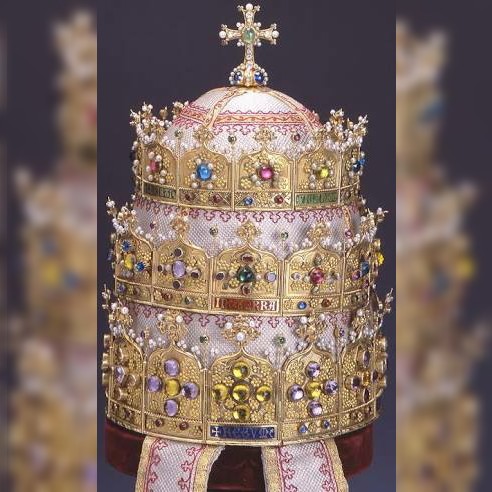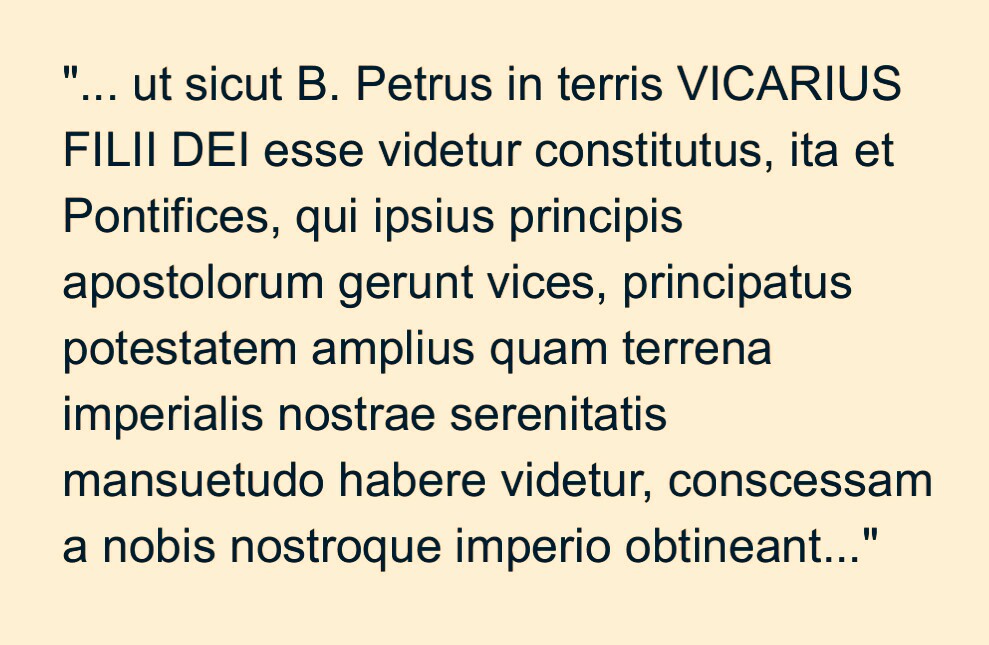
The anti-Catholics condemned the Holy Catholic Church for an alleged title of the Pope — the Vicarius Filii Dei (Vicar of the Son of God). According to them, “The pope is the beast spoken of in Revelation 13. Verse 1 says that he wears crowns and has ‘blasphemous names’ written on his head. Verse 18 says that the numerical value of his name adds up to 666. The pope’s official title in Latin is Vicarius Filii Dei. If that is added up using Roman numerals, it sums up to 666. The pope’s tiara is emblazoned with this title, formed by diamonds and other jewels.” But, is the Pope really the blasphemous Beast forseen by St. John?
On the accusations, the proponents of the controversy used several so-called evidences to support their claim. However, how realiable these evidences are?
The title Vicarius Filii Dei was used in several Catholic documents referring to the Pope, as follows:
OBJECTION: Vicarius Filii Dei has never been an official title of any Pope since the earliest centuries of the Church. The description in itself is theologically accurate when referring to the Pope and bishops but its inclusion in any church documents does not immediately mean that it is a Papal official title.
⚫ In the early collection of canon law, the Decretum of Gratian, first published in 1148, we read, (Latin) “Beatus Petrus in terris vicarius Filii Dei videtur esse consitutus.” Translated into English, it means, “Blessed Peter is seen to have been constituted vicar of the Son of God on earth.” In the revised Corpus of Canon Law (sic), published by order of Pope Gregory XIII, it was to be corrected by, ‘the plenitude of apostolic power,’ so that it is, ‘entirely freed from faults.’ Therein also written the same statement found in the Decretum of Gratian.
OBJECTION: The use of Decretum of Gratian and the Corpus of Canon Law as evidences that Vicarius Filii Dei is contained in “official” Catholic documents is absurd since those sections of the Decretum and the Corpus cited are actually from the Donation of Constantine, a famous forged state document in the European medieval history. Thus, a forged document is not an “official Catholic document,” even though it may have been regarded by many as authentic.
⚫ When Lucius Ferraris wrote, Prompta Bibliotheca in 1755, he gave under the article ‘Papa,’ the title, Vicarius Filii Dei.
OBJECTION: Citing Fr. Lucius Ferraris’ Prompta Bibliotheca as further evidence that Vicarius Filii Dei is an official title of the Pope is also absurd because the section of Prompta Bibliotheca quoted is also from the Donation of Constantine forgery. Naturally, Fr. Ferraris, a Franciscan ecclesiastical historian, could have been considerably more careful in his use of sources, given the fact that for fully 300 years before he compiled the Prompta Bibliotheca, it was widely known that the Donation of Constantine was a forgery. But again, his injudicious inclusion of the forgery hardly constitutes evidence of Vicarius Filii Dei being used as an official title of the pope.
⚫ A subscriber to Our Sunday Visitor, a Catholic weekly periodical, wrote a letter to the editor, wherein he asked, ‘What are the letters supposed to be in the pope’s crown, and what do they signify, if anything?’ The answer given was, ‘The letters inscribed on the pope’s mitre are these: Vicarius Filii Dei, which is Latin for, Vicar of the Son of God’ (April 18, 1915, Vol. 3, Number 51, p. 3).
OBJECTION: Quoting from a 1915 edition of Our Sunday Visitor newspaper, to the effect that the papal mitre is inscribed with diamonds with the title Vicarius Filii Dei is in mala fide (bad faith). Robert Lockwood, the president of Our Sunday Visitor, had written a letter on behalf of Our Sunday Visitor explaining that the 1915 remark regarding the alleged inscription on the pope’s mitre was an unintentional and unfortunate error that should not be used as “evidence” to support the Vicarius Filii Dei argument. A copy of this letter is being sent to the Seventh-Day Adventist headquarters, demanding that they stop using this episode as some sort of “proof” to prop up their argument. Remember that the holy Catholic Church does not claim infallibility for journalists.
⚫ In “Crossing The Threshold of Hope”, by St. John Paul II: First Chapter: “The Pope”: A Scandal and a Mystery, page 3: “The Pope is considered the man on earth who represents the Son of God, who takes the place of the Second Person of the omnipotent God of the Trinity”. The direct translation of “represents the Son of God” into Latin, the official language of the Church is “Vicarius Filii Dei”.
OBJECTION: The use of St. John Paul II’s Crossing the Threshold of Hope has nothing to do with Vicarius Filii Dei because the phrase “Represents the Son of God,” translated directly into Latin, yields “Filium Dei Repraesentat, not Vicarius Filii Dei. It should suffice to point out that “represents” is a verb and “vicar” is a noun.
The Pope of Rome wore a crown with the inscription, Vicarius Filii Dei, as seen by several witnesses:
OBJECTION: The tiara used by the Pope has no inscription, Vicarius Filii Dei. There is only one tiara that has a major writing on it, i.e. the Belgian tiara of 1871 but it does not feature Vicarius Filii Dei or words even remotely similar but it reads Christi Vicario in Terra Regum, with the words spread out over three lairs. At present, there are in fact over twenty surviving tiaras in existence that can be viewed and checked. The earliest tiara dates from the sixteenth century and the latest from 2011. Eleven of them are held in the Vatican and two are permanently on display in the United States at the National Shrine of the Immaculate Conception in Washington, D.C. and at the Basilica of the Sacred Heart, Indiana at the University of Notre Dame.
⚫ A protestant woman visiting Rome said she witnessed Pope Gregory XVI wearing a crown with the words on it, in or around 1832.
OBJECTION: In 1832, only two tiaras existed; one from the sixteenth century and one, given by Napoleon I to Pope Pius VII in 1804. None of those tiaras contain the said inscription.
⚫ Pope Gregory XVI had worn a papal tiara with these words clearly visible on it at a Pontifical High Mass during Easter 1845.
OBJECTION: Pope Gregory XVI could not have worn a triple tiara containing the alleged words during Easter Mass in 1845, because, as has been mentioned, papal tiaras were not worn during religious ceremonial most especially not during Mass. (The only principal exception, when a pope gave his traditional urbi et orbi blessing wearing the Tiara, occurred high up on a balcony and could not possibly be confused with a Mass celebrated at an altar.)
⚫ The existence of a photograph of a papal funeral at the start of the twentieth century (which probably means the funeral of Pope Leo XIII in 1903 but could possibly be Pope Pius X’s in 1914) showing the words on a papal tiara.
OBJECTION: All of the tiaras in existence at the time of the creation of photography and hence in the timeframe for the mysterious ‘photographic evidence’ still exist and have been accounted for, through receipts, repair records, valuations, etc. but no tiara other than those currently in existence has existed since the destruction of early tiaras by Napoleon’s soldiers at the beginning of nineteenth century. Though the evidence supposed ‘exists’ in the form of a photograph, in nearly one hundred years no-one has been able to produce the photograph, or even give definitive evidence of its existence, such as stating where exactly it was published.
⚫ The tiara (with the words mentioned) is always used to crown popes, but specifically was used in 1939 to crown Eugenio Pacelli as Pope Pius XII.
OBEJECTION: There is not one Papal Tiara but many, with numerous ones being used for different popes, often with the decision on which one to use being decided on the basis of which one corresponded most closely to papal head size. Yet the anti-Catholics, promoting the myth, speak of the same tiara always being used. On the other hand, the papal tiara used in the coronation of Pope Pius XII, which was explicitly stated by the anti-Catholics as being the tiara with the Vicarius Filii Dei words spelt out in jewellery and diamonds was in fact manufactured in 1877 and so could not have been the tiara with those words supposedly seen in 1832 or 1845.
FURTHERMORE, “Why do the anti-Catholics and other papal critics insist on using a Latin phrase (ie. Vicarius Filii Dei) to arrive at 666, when the Book of Revelation was written, not in Latin, but in Greek?”
The answer is simple. The use of Greek gematria in identifying the numerical value of the beast’s name in the papal title would place their accusations unsupported.
Take note that the Pope never assumed the cathedra of Rome with Vicarius Filii Dei as his official title. As a matter of fact, based on the Annuario Pontificio, the Pope has the following official titles:

The best-known title, that of “Pope”, does not even appear in the list of official titles, but is commonly used in the titles of documents, and appears, in abbreviated form, in their signatures, e.g. Pope Paul VI signed as Paulus PP. VI, the PP. standing for Papa (Pope).

AGAIN, there is only one papal tiara that has inscription on it and that is the Belgian Tiara — a magnificent gift from the court of Leopold II to Pope Pius IX in 1871. It bears NO inscription: Vicarius Filii Dei; but the words: CHRISTI VICARIO – IN TERRA – REGUM.
Below is the most celebrated forged document, the Donation of Constantine:

In English that is-
“… as the Blessed Peter is seen to have been constituted VICAR OF THE SON OF GOD on the earth, so the Pontiffs who are the representatives of that same chief of the apostles, should obtain from us and our empire the power of a supremacy greater than the clemency of our earthly imperial serenity is seen to have conceded to it …”
Hence, to emphasize, the use of this forged document to persecute the holy Catholic Church is a shame. Notice that in the said document, it was St. Peter who was called to be the vicar of the Son of God, yet St. Peter is not the Beast in the Book of Revelation.
Now the question would be, who then is the beast with the blasphemous name 666 in the Book of Revelation?
Urging to urderstand that Vicarius Filii Dei, if it is really a Pope’s official title, is not a man’s name but a mere description of authority. The beast forseen by St. John has a NAME OF A MAN that counts to 666.
“And that no man might buy or sell, save he that had the mark, or the name of the beast, or the number of his name. Here is wisdom. Let him that hath understanding count the number of the beast: for it is the number of a man; and his number is Six hundred threescore and six.”
— Revelation 13:17-18 —
Thus, the Pope is not the beast with blasphemous name. The Vicarius Filii Dei is neither a pope’s name nor his official title.
“If the person making this claim disputes these facts, ask him to furnish an example of the alleged title, Vicarius Filii Dei, being used officially by a pope. You won’t encounter papal decrees, conciliar statements, or other authentic, official Catholic documents in which the pope calls himself the ‘Vicar of the Son of God.’ Why? Because no such examples exist. Vicarius Filii Dei has never been an official title of the pope.” (Pope Fiction, by Patrick Madrid, 1999, pg. 91.)
“There are men who will build up a hundred weak and frivolous arguments against Catholicity, that they may have the easy pleasure of refuting them. They remind me of children who build up houses of tile-shards, such sport is it for them to cast then down again.” -St. Thomas More-
